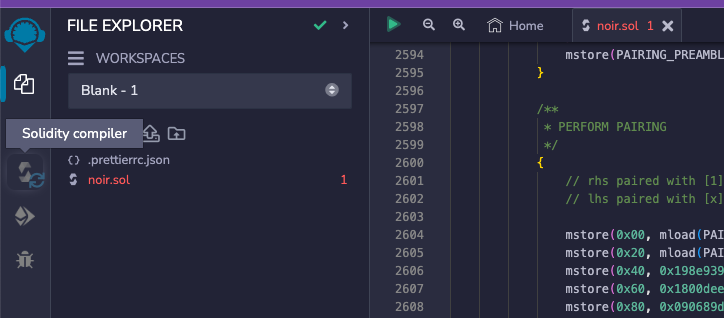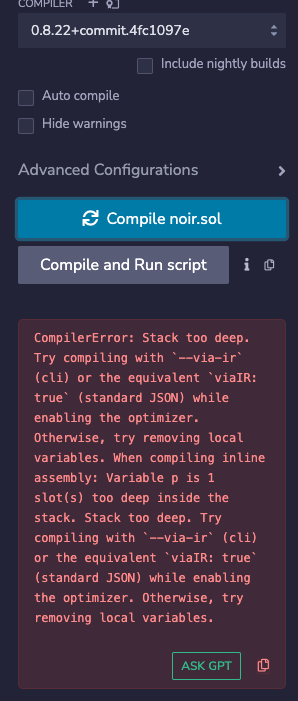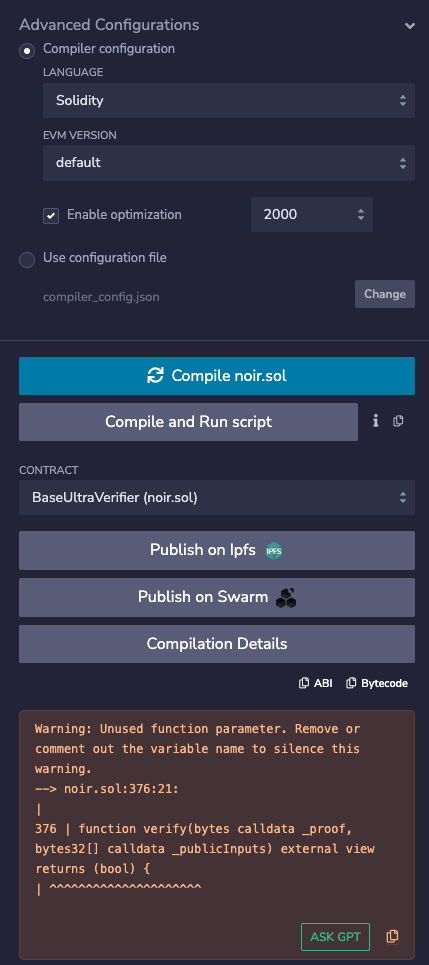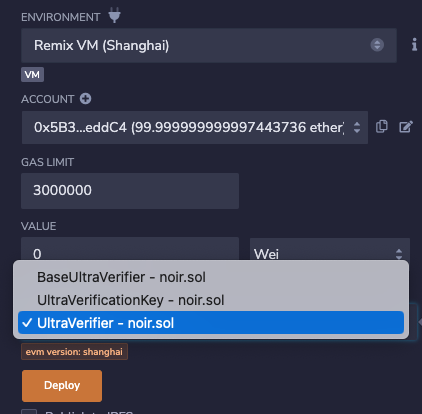Generate a Solidity Verifier
Noir has the ability to generate a verifier contract in Solidity, which can be deployed in many EVM-compatible blockchains such as Ethereum.
This allows for a powerful feature set, as one can make use of the conciseness and the privacy provided by Noir in an immutable ledger. Applications can range from simple P2P guessing games, to complex private DeFi interactions.
This guide shows you how to generate a Solidity Verifier and deploy it on the Remix IDE. It is assumed that:
- You are comfortable with the Solidity programming language and understand how contracts are deployed on the Ethereum network
- You have Noir installed and you have a Noir program. If you don't, get started with Nargo and the example Hello Noir circuit
- You are comfortable navigating RemixIDE. If you aren't or you need a refresher, you can find some video tutorials here that could help you.
Rundown
Generating a Solidity Verifier contract is actually a one-command process. However, compiling it and deploying it can have some caveats. Here's the rundown of this guide:
- How to generate a solidity smart contract
- How to compile the smart contract in the RemixIDE
- How to deploy it to a testnet
Step 1 - Generate a contract
This is by far the most straightforward step. Just run:
nargo compile
This will compile your source code into a Noir build artifact to be stored in the ./target directory, you can then generate the smart contract using the commands:
# Here we pass the path to the newly generated Noir artifact.
bb write_vk -b ./target/<noir_artifact_name>.json
bb contract
replacing <noir_artifact_name> with the name of your Noir project. A new contract folder would then be generated in your project directory, containing the Solidity
file contract.sol. It can be deployed to any EVM blockchain acting as a verifier smart contract.
You can find more information about bb and the default Noir proving backend on this page.
It is possible to generate verifier contracts of Noir programs for other smart contract platforms as long as the proving backend supplies an implementation.
Barretenberg, the default proving backend for Nargo, supports generation of verifier contracts, for the time being these are only in Solidity.
Step 2 - Compiling
We will mostly skip the details of RemixIDE, as the UI can change from version to version. For now, we can just open Remix and create a blank workspace.

We will create a new file to contain the contract Nargo generated, and copy-paste its content.
You'll likely see a warning advising you to not trust pasted code. While it is an important warning, it is irrelevant in the context of this guide and can be ignored. We will not be deploying anywhere near a mainnet.
To compile our the verifier, we can navigate to the compilation tab:

Remix should automatically match a suitable compiler version. However, hitting the "Compile" button will most likely generate a "Stack too deep" error:

This is due to the verify function needing to put many variables on the stack, but enabling the optimizer resolves the issue. To do this, let's open the "Advanced Configurations" tab and enable optimization. The default 200 runs will suffice.
This time we will see a warning about an unused function parameter. This is expected, as the verify function doesn't use the _proof parameter inside a solidity block, it is loaded from calldata and used in assembly.

Step 3 - Deploying
At this point we should have a compiled contract ready to deploy. If we navigate to the deploy section in Remix, we will see many different environments we can deploy to. The steps to deploy on each environment would be out-of-scope for this guide, so we will just use the default Remix VM.
Looking closely, we will notice that our "Solidity Verifier" is actually three contracts working together:
- An
UltraVerificationKeylibrary which simply stores the verification key for our circuit. - An abstract contract
BaseUltraVerifiercontaining most of the verifying logic. - A main
UltraVerifiercontract that inherits from the Base and uses the Key contract.
Remix will take care of the dependencies for us so we can simply deploy the UltraVerifier contract by selecting it and hitting "deploy":

A contract will show up in the "Deployed Contracts" section, where we can retrieve the Verification Key Hash. This is particularly useful for double-checking that the deployer contract is the correct one.
Why "UltraVerifier"?
To be precise, the Noir compiler (nargo) doesn't generate the verifier contract directly. It compiles the Noir code into an intermediate language (ACIR), which is then executed by the backend. So it is the backend that returns the verifier smart contract, not Noir.
In this case, the Barretenberg Backend uses the UltraPlonk proving system, hence the "UltraVerifier" name.
Step 4 - Verifying
To verify a proof using the Solidity verifier contract, we call the verify function in this extended contract:
function verify(bytes calldata _proof, bytes32[] calldata _publicInputs) external view returns (bool)
When using the default example in the Hello Noir guide, the easiest way to confirm that the verifier contract is doing its job is by calling the verify function via remix with the required parameters. Note that the public inputs must be passed in separately to the rest of the proof so we must split the proof as returned from bb.
First generate a proof with bb at the location ./proof using the steps in get started, this proof is in a binary format but we want to convert it into a hex string to pass into Remix, this can be done with the
# This value must be changed to match the number of public inputs (including return values!) in your program.
NUM_PUBLIC_INPUTS=1
PUBLIC_INPUT_BYTES=32*NUM_PUBLIC_INPUTS
HEX_PUBLIC_INPUTS=$(head -c $PUBLIC_INPUT_BYTES ./proof | od -An -v -t x1 | tr -d $' \n')
HEX_PROOF=$(tail -c +$(($PUBLIC_INPUT_BYTES + 1)) ./proof | od -An -v -t x1 | tr -d $' \n')
echo "Public inputs:"
echo $HEX_PUBLIC_INPUTS
echo "Proof:"
echo "0x$HEX_PROOF"
Remix expects that the public inputs will be split into an array of bytes32 values so HEX_PUBLIC_INPUTS needs to be split up into 32 byte chunks which are prefixed with 0x accordingly.
A programmatic example of how the verify function is called can be seen in the example zk voting application here:
function castVote(bytes calldata proof, uint proposalId, uint vote, bytes32 nullifierHash) public returns (bool) {
// ...
bytes32[] memory publicInputs = new bytes32[](4);
publicInputs[0] = merkleRoot;
publicInputs[1] = bytes32(proposalId);
publicInputs[2] = bytes32(vote);
publicInputs[3] = nullifierHash;
require(verifier.verify(proof, publicInputs), "Invalid proof");
A circuit doesn't have the concept of a return value. Return values are just syntactic sugar in Noir.
Under the hood, the return value is passed as an input to the circuit and is checked at the end of the circuit program.
For example, if you have Noir program like this:
fn main(
// Public inputs
pubkey_x: pub Field,
pubkey_y: pub Field,
// Private inputs
priv_key: Field,
) -> pub Field
the verify function will expect the public inputs array (second function parameter) to be of length 3, the two inputs and the return value.
Passing only two inputs will result in an error such as PUBLIC_INPUT_COUNT_INVALID(3, 2).
In this case, the inputs parameter to verify would be an array ordered as [pubkey_x, pubkey_y, return.
You can pass structs to the verifier contract. They will be flattened so that the array of inputs is 1-dimensional array.
For example, consider the following program:
struct Type1 {
val1: Field,
val2: Field,
}
struct Nested {
t1: Type1,
is_true: bool,
}
fn main(x: pub Field, nested: pub Nested, y: pub Field) {
//...
}
The order of these inputs would be flattened to: [x, nested.t1.val1, nested.t1.val2, nested.is_true, y]
The other function you can call is our entrypoint verify function, as defined above.
It's worth noticing that the verify function is actually a view function. A view function does not alter the blockchain state, so it doesn't need to be distributed (i.e. it will run only on the executing node), and therefore doesn't cost any gas.
This can be particularly useful in some situations. If Alice generated a proof and wants Bob to verify its correctness, Bob doesn't need to run Nargo, NoirJS, or any Noir specific infrastructure. He can simply make a call to the blockchain with the proof and verify it is correct without paying any gas.
It would be incorrect to say that a Noir proof verification costs any gas at all. However, most of the time the result of verify is used to modify state (for example, to update a balance, a game state, etc). In that case the whole network needs to execute it, which does incur gas costs (calldata and execution, but not storage).
A Note on EVM chains
Noir proof verification requires the ecMul, ecAdd and ecPairing precompiles. Not all EVM chains support EC Pairings, notably some of the ZK-EVMs. This means that you won't be able to use the verifier contract in all of them. You can find an incomplete list of which EVM chains support these precompiles here.
For example, chains like zkSync ERA and Polygon zkEVM do not currently support these precompiles, so proof verification via Solidity verifier contracts won't work. Here's a quick list of EVM chains that have been tested and are known to work:
- Optimism
- Arbitrum
- Polygon PoS
- Scroll
- Celo
- BSC
- Blast L2
- Avalanche C-Chain
- Mode
- Linea
- Moonbeam
If you test any other chains, please open a PR on this page to update the list. See this doc for more info about testing verifier contracts on different EVM chains.
What's next
Now that you know how to call a Noir Solidity Verifier on a smart contract using Remix, you should be comfortable with using it with some programmatic frameworks, such as hardhat and foundry.
You can find other tools, examples, boilerplates and libraries in the awesome-noir repository.
You should also be ready to write and deploy your first NoirJS app and start generating proofs on websites, phones, and NodeJS environments! Head on to the NoirJS tutorial to learn how to do that.